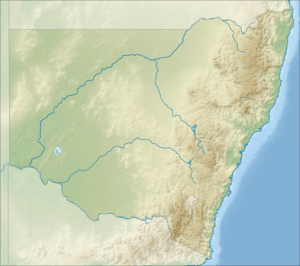Geehi Dam
| Geehi Dam | |
|---|---|
 Location of Geehi Dam in New South Wales | |
| Country | Australia |
| Location | Snowy Mountains, New South Wales |
| Coordinates | 36°17′54″S 148°19′04″E / 36.29833°S 148.31778°ECoordinates: 36°17′54″S 148°19′04″E / 36.29833°S 148.31778°E |
| Status | Operational |
| Opening date | 1966 |
| Owner(s) | Snowy Hydro |
| Dam and spillways | |
| Type of dam | Embankment dam |
| Impounds | Geehi River |
| Height | 91 metres (299 ft) |
| Length | 265 metres (869 ft) |
| Dam volume | 1.421 million cubic metres (50.2×106 cu ft) |
| Spillways | 1 |
| Spillway type | Uncontrolled glory hole |
| Spillway capacity | 1,534 cubic metres per second (54,200 cu ft/s) |
| Reservoir | |
| Creates | Geehi Reservoir |
| Total capacity | 21,093 megalitres (744.9×106 cu ft) |
| Catchment area | 149 square kilometres (58 sq mi) |
| Surface area | 700 hectares (1,700 acres) |
| Power station | |
| Operator(s) | Snowy Hydro |
| Commission date | 1967 |
| Type | Conventional |
| Hydraulic head | 460.2 metres (1,510 ft) |
| Turbines | 10 |
| Installed capacity | 950 megawatts (1,270,000 hp) |
Geehi Dam is a major ungated rockfill embankment dam with an uncontrolled glory hole spillway across the Geehi River in the Snowy Mountains of New South Wales, Australia. The dam's main purpose is for the generation of hydro-power and is one of the sixteen major dams that comprise the Snowy Mountains Scheme, a vast hydroelectricity and irrigation complex constructed in south-east Australia between 1949 and 1974 and now run by Snowy Hydro.
The impounded reservoir is called the Geehi Reservoir.
Location and features
Completed in 1966, Geehi Dam is a major dam, located within the Tumbarumba Shire. The dam was constructed by Thiess Bros based on engineering plans developed under contract by the Snowy Mountains Hydroelectric Authority.[1]
The dam wall comprising 1,421,000 cubic metres (50,200,000 cu ft) of rockfill with an earth internal core is 91 metres (299 ft) high and 265 metres (869 ft) long. At 100% capacity the dam wall holds back 21,093 megalitres (744.9×106 cu ft) of water. The surface area of Geehi Reservoir is 700 hectares (1,700 acres) and the catchment area is 149 square kilometres (58 sq mi). The 32m (105 ft) diameter uncontrolled bell-mouth OR glory hole spillway is capable of discharging 1,534 cubic metres per second (54,200 cu ft/s).[1][2]
Power generation
Fed by the pumped flows via the Snowy-Geehi Haupt-tunnel from Island Bend Pondage and Geehi Reservoir, is the above ground Murray 1 conventional hydroelectric power station. Completed in 1967, the power station has ten Boving Engineering UK-manufactured turbines comprising ASEA-manufactured generators, with a combined generating capacity of 950 megawatts (1,270,000 hp) of electricity; a net generation of 1,413 gigawatt-hours (5,090 TJ) per annum; and has 460.2 metres (1,510 ft) rated hydraulic head.[3]
The power station is located 24 kilometres (15 mi) from the Jindabyne Pumping Station on the Alpine Way, near the town of Khancoban, at the site of the Snowy Hydro Murray 1 Power Station and Visitors Centre. The station is capable of producing enough electricity to supply over 95,000 homes.[4]
See also
- Kosciuszko National Park
- List of dams and reservoirs in New South Wales
- Snowy Hydro Limited
- Snowy Mountains Scheme
- Snowy Scheme Museum
References
- 1 2 "Register of Large Dams in Australia" (Excel (requires download)). Dams information. The Australian National Committee on Large Dams Incorporated. 2010. Retrieved 11 May 2013.
- ↑ "Dams". Snowy Mountains Scheme. Snowy Hydro. Retrieved 11 May 2013.
- ↑ "Murray-I Hydroelectric Power Plant Australia". Global Energy Observatory. 11 May 2012. Retrieved 11 May 2013.
- ↑ "Murray 1 Power Station and Visitors Centre". Kosciuszko Alpine Way. 2013. Retrieved 11 May 2013.
External links
- Bevitt, R.; Erskine, W.; Gillespie, G.; Harriss, J.; Lake, P.; Miners, B.; Varley, I. (May 2009). "Expert panel environmental flow assessment of various rivers affected by the Snowy Mountains Scheme" (PDF). NSW Department of Water and Energy. ISBN 978-0-7347-5656-5.